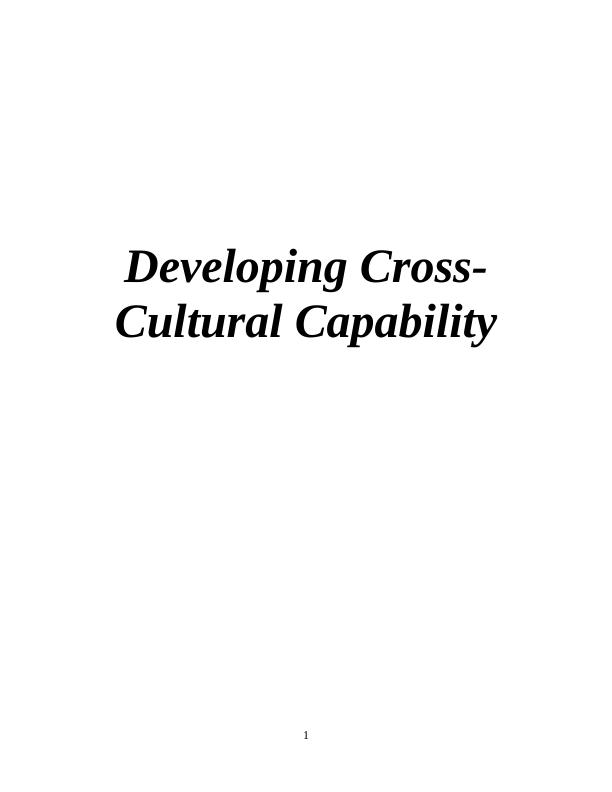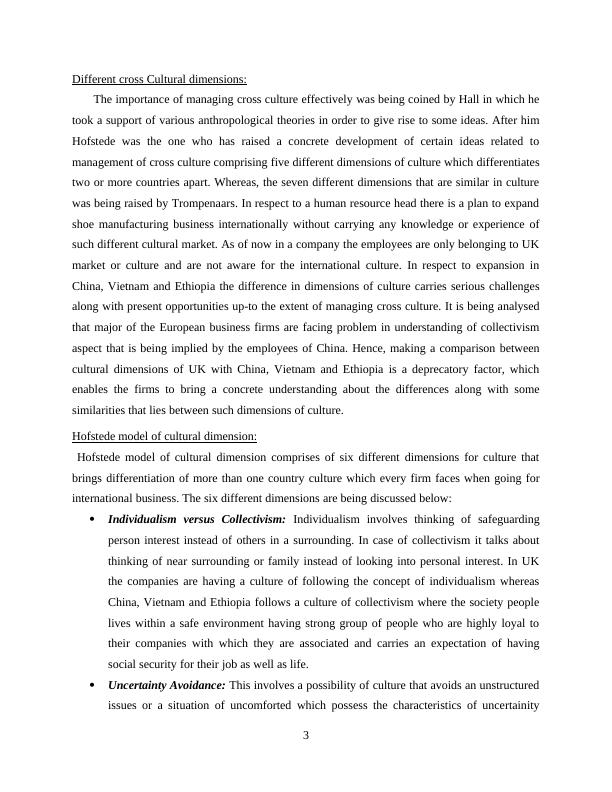Developing Cross-Cultural Capability
Added on 2022-12-14
6 Pages1969 Words168 Views
Developing Cross-
Cultural Capability
1
Cultural Capability
1

INTRODUCTION
A collaboration of organisational environment, framework as well as dynamics of teams are
having a great shift from last several years due to the impact of globalisation within industry
which comprises of high proximity in respect to sharing of knowledge across globe. Now a days
many domestic companies are trying to into an international business to have competitive
advantage within a market and hence are targeting a wide range of customers that will help them
in increasing their business along with an achievement of growth. The another reason for
business expansion is diversification of risk through a portfolio that brings income from more
than one source and attain valuable insights in respect to the culture of foreign countries. The
present report comprises of a shoe manufacturing company that is Loake Shoemakers which is
having a plan to expand its shoe business in China, Vietnam and Ethiopia. Loake shoemakers is
having it’s headquarter in UK being established in year 1880 wishing to have expansion into
such countries where the company faces entirely new or different culture. A company can have
to face certain challenges related to cultural diversity along with a scope of great opportunity. In
order to cope up with the challenges and meeting demands in new culture the company has a
plan to hire some employees from the local environment who will be held responsible in
managing company’s operations there. The report comprises upon a discussion on some
considerations that are related to human resource and cross culture which can be emerged during
the shift of production.
TASK
Overview of the company:
Loake Shoemakers is a private company based in UK being established in year 1880 by
John, Thomas and William Loake in a form of production firm that manufactures shoes in the
areas of Northamptonshire. The company is having its specialisation in manufacturing of men’s
shoes which are traditionally handmade. With the happening of declining in British production
along with a negative market condition the company has expanded its business to India in a form
of joint venture so to have diversification of its risk and maintaining its sales.
2
A collaboration of organisational environment, framework as well as dynamics of teams are
having a great shift from last several years due to the impact of globalisation within industry
which comprises of high proximity in respect to sharing of knowledge across globe. Now a days
many domestic companies are trying to into an international business to have competitive
advantage within a market and hence are targeting a wide range of customers that will help them
in increasing their business along with an achievement of growth. The another reason for
business expansion is diversification of risk through a portfolio that brings income from more
than one source and attain valuable insights in respect to the culture of foreign countries. The
present report comprises of a shoe manufacturing company that is Loake Shoemakers which is
having a plan to expand its shoe business in China, Vietnam and Ethiopia. Loake shoemakers is
having it’s headquarter in UK being established in year 1880 wishing to have expansion into
such countries where the company faces entirely new or different culture. A company can have
to face certain challenges related to cultural diversity along with a scope of great opportunity. In
order to cope up with the challenges and meeting demands in new culture the company has a
plan to hire some employees from the local environment who will be held responsible in
managing company’s operations there. The report comprises upon a discussion on some
considerations that are related to human resource and cross culture which can be emerged during
the shift of production.
TASK
Overview of the company:
Loake Shoemakers is a private company based in UK being established in year 1880 by
John, Thomas and William Loake in a form of production firm that manufactures shoes in the
areas of Northamptonshire. The company is having its specialisation in manufacturing of men’s
shoes which are traditionally handmade. With the happening of declining in British production
along with a negative market condition the company has expanded its business to India in a form
of joint venture so to have diversification of its risk and maintaining its sales.
2

Different cross Cultural dimensions:
The importance of managing cross culture effectively was being coined by Hall in which he
took a support of various anthropological theories in order to give rise to some ideas. After him
Hofstede was the one who has raised a concrete development of certain ideas related to
management of cross culture comprising five different dimensions of culture which differentiates
two or more countries apart. Whereas, the seven different dimensions that are similar in culture
was being raised by Trompenaars. In respect to a human resource head there is a plan to expand
shoe manufacturing business internationally without carrying any knowledge or experience of
such different cultural market. As of now in a company the employees are only belonging to UK
market or culture and are not aware for the international culture. In respect to expansion in
China, Vietnam and Ethiopia the difference in dimensions of culture carries serious challenges
along with present opportunities up-to the extent of managing cross culture. It is being analysed
that major of the European business firms are facing problem in understanding of collectivism
aspect that is being implied by the employees of China. Hence, making a comparison between
cultural dimensions of UK with China, Vietnam and Ethiopia is a deprecatory factor, which
enables the firms to bring a concrete understanding about the differences along with some
similarities that lies between such dimensions of culture.
Hofstede model of cultural dimension:
Hofstede model of cultural dimension comprises of six different dimensions for culture that
brings differentiation of more than one country culture which every firm faces when going for
international business. The six different dimensions are being discussed below:
Individualism versus Collectivism: Individualism involves thinking of safeguarding
person interest instead of others in a surrounding. In case of collectivism it talks about
thinking of near surrounding or family instead of looking into personal interest. In UK
the companies are having a culture of following the concept of individualism whereas
China, Vietnam and Ethiopia follows a culture of collectivism where the society people
lives within a safe environment having strong group of people who are highly loyal to
their companies with which they are associated and carries an expectation of having
social security for their job as well as life.
Uncertainty Avoidance: This involves a possibility of culture that avoids an unstructured
issues or a situation of uncomforted which possess the characteristics of uncertainity
3
The importance of managing cross culture effectively was being coined by Hall in which he
took a support of various anthropological theories in order to give rise to some ideas. After him
Hofstede was the one who has raised a concrete development of certain ideas related to
management of cross culture comprising five different dimensions of culture which differentiates
two or more countries apart. Whereas, the seven different dimensions that are similar in culture
was being raised by Trompenaars. In respect to a human resource head there is a plan to expand
shoe manufacturing business internationally without carrying any knowledge or experience of
such different cultural market. As of now in a company the employees are only belonging to UK
market or culture and are not aware for the international culture. In respect to expansion in
China, Vietnam and Ethiopia the difference in dimensions of culture carries serious challenges
along with present opportunities up-to the extent of managing cross culture. It is being analysed
that major of the European business firms are facing problem in understanding of collectivism
aspect that is being implied by the employees of China. Hence, making a comparison between
cultural dimensions of UK with China, Vietnam and Ethiopia is a deprecatory factor, which
enables the firms to bring a concrete understanding about the differences along with some
similarities that lies between such dimensions of culture.
Hofstede model of cultural dimension:
Hofstede model of cultural dimension comprises of six different dimensions for culture that
brings differentiation of more than one country culture which every firm faces when going for
international business. The six different dimensions are being discussed below:
Individualism versus Collectivism: Individualism involves thinking of safeguarding
person interest instead of others in a surrounding. In case of collectivism it talks about
thinking of near surrounding or family instead of looking into personal interest. In UK
the companies are having a culture of following the concept of individualism whereas
China, Vietnam and Ethiopia follows a culture of collectivism where the society people
lives within a safe environment having strong group of people who are highly loyal to
their companies with which they are associated and carries an expectation of having
social security for their job as well as life.
Uncertainty Avoidance: This involves a possibility of culture that avoids an unstructured
issues or a situation of uncomforted which possess the characteristics of uncertainity
3

End of preview
Want to access all the pages? Upload your documents or become a member.
Related Documents
HR-related Issues in Partial Business Shift to Chinalg...
|11
|2916
|25
Opportunities and Risks Related to Partial Shift of Manufacturing Concerned with Move to Other Countrieslg...
|10
|3215
|410
Developing Cross-Cultural Capabilitylg...
|11
|3425
|489
Developing Cross Cultural Capabilitylg...
|11
|2990
|31
Developing Cross-cultural Capabilitieslg...
|10
|3124
|104
HR-related issues in Cross Cultural Comparisonlg...
|11
|3241
|41